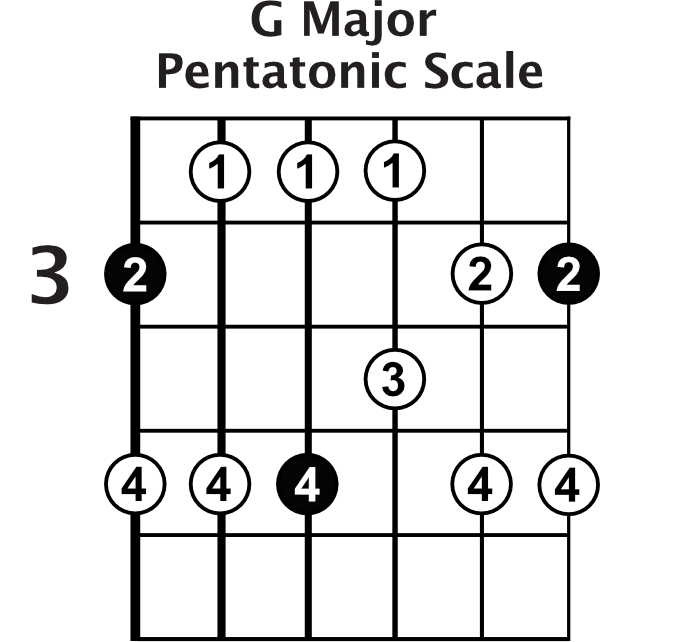You’ll remember in the G major scale shape, there are seven notes repeated in multiple octaves. In the major pentatonic scale, we simply take two of those notes out of each octave. Essentially we’ll play the G major scale, but leave out the fourth and seventh note out.

Welcome to the fourth lesson of the Lead Guitar Quick-Start Series. In this lesson, we’ll be taking a look at the major pentatonic scale. The major pentatonic scale is very versatile, and it’s used in almost every genre of music. We’ll also be going over muting technique in this lesson, so that you can play through these scales cleanly.

We’ll start by looking at our G major scale shape that we went over in the least lesson. The G major pentatonic scale comes from the G major scale. All we’re going to do to turn our G major scale to a G major pentatonic scale is leave out the fourth and seventh notes. Leaving these notes out will make playing the shape a lot easier since there will only be two notes per string.
Penta means five. Since this scale has five notes, we call it the pentatonic scale. As you work on playing through this new scale shape, remember all the tips we went over in the previous lesson about the major scale. Stay relaxed and make small motions with your pick.
One thing you’ll notice when playing through this new scale shape is that you’ll be using your pinky finger a lot. If you haven’t played much lead guitar in the past, it’s likely that your pinky finger might not be too strong yet. Practicing this scale shape will be a great opportunity for you to work on strengthening it.
As you continue to learn how to play lead guitar, an important technique you’ll need to work on is muting. Being able to avoid the ringing noise of other strings you didn’t mean to play will help separate you from the average lead guitar player. There are two ways of muting the strings you’re not playing, and the first we’ll look at in this series is using your fretting hand.
In the first lesson of the Lead Guitar Quick-Start Series, we talked about good finger posture and coming down on the strings with the tips of your fingers. This won’t always be the case as a lead guitar player. If the tip of your finger is straight down on the E string, then you will want to lightly brush up against the A string too. Now if you accidentally strum the A string with your picking hand, the A string will be muted and won’t sound out.
In the next video, we’ll learn how to play the minor pentatonic scale. The minor pentatonic scale is possibly the most popular scale among guitar players.
Are you looking for more lead guitar lessons and relevant jam-tracks? Guitareo is Nate Savage’s step-by-step video training system. It has some great songs for lead guitar and it also covers many other important styles of music including rock, country, fingerstyle, metal, classical, bluegrass, jazz, and more. Best of all it includes a huge library of original jam-tracks so you can apply everything to music.